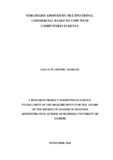| dc.description.abstract | The challenges of the business environment characterized by fragmented markets, increased competition, rapid technological changes, shifting regulatory frameworks, and a growing dependence on non-price competition have forced many businesses to more closely scrutinize their competitive strategy. Generally, organizations operate within an environment with high competition which influences the firm‟s strategic process and determines the firm‟s growth. The available theoretical framework although it tries to give the basis of strategies, it seems not to be in consensus onto which strategies are most appropriate. Game theory and open systems theory hold that the choice of strategy or implementation is highly pre-determined by the choices being used by other firms. Resource Based View Theory on the other hand speculates that the available firms‟ resources are what determines the strategies a particular firm can be able to adopt and to which extent. The banking sector in particular owing to the fact that it is one of the most competitive industries in the country. The objective of this study was to identify competitive strategies used by multinational commercial banks in Kenya to cope to competition. The study was considered important to the management of multinational corporations whom from the study, they would be able to evaluate which strategies are crucial in gaining competitive advantage. This was capable of enabling them to identify gaps in their strategies which may enhance their strategic response and as a result move to effectively manage the existing strategies which will improve performance. The study was also considered to be important in policy making by financial regulatory organs in government financial regulatory organs in developing and enacting policies which was to ensure sustainable operations of financial institutions in the county. A descriptive survey research design was adopted in conducting the study. The approach was used to obtain data concerning the current status of the phenomena. The target population for this study was all the eighteen multinational banks registered by the Central Bank of Kenya as at July 2015 and the primary data was collected by use of a standard questionnaires. Descriptive statistics such as means and standard deviations were used to analyze the data. The descriptive analysis was useful in giving summaries. The reliability of the items was conducted using Cronbach Alpha test. The study established that Multinational commercial banks in Kenya adopted competitive strategies in form of cost leadership, differentiation and focus strategies to cope to competition. The study concluded that a firm‟s competitive advantage is not sourced from adoption of one strategy but a combination of many strategies. The study recommends that the banks should carefully evaluate their resources and utilize them to the maximum in gaining of competitive advantage. Finally, replication of the study in different sectors under different circumstances would be welcome to establish the validity and generalizability of the present findings across different sectors and contexts. | en_US |



